The AMD Radeon VII Review: An Unexpected Shot At The High-End
by Nate Oh on February 7, 2019 9:00 AM ESTWolfenstein II: The New Colossus (Vulkan)
id Software is popularly known for a few games involving shooting stuff until it dies, just with different 'stuff' for each one: Nazis, demons, or other players while scorning the laws of physics. Wolfenstein II is the latest of the first, the sequel of a modern reboot series developed by MachineGames and built on id Tech 6. While the tone is significantly less pulpy nowadays, the game is still a frenetic FPS at heart, succeeding DOOM as a modern Vulkan flagship title and arriving as a pure Vullkan implementation rather than the originally OpenGL DOOM.
Featuring a Nazi-occupied America of 1961, Wolfenstein II is lushly designed yet not oppressively intensive on the hardware, something that goes well with its pace of action that emerge suddenly from a level design flush with alternate historical details.
The highest quality preset, "Mein leben!", was used. Wolfenstein II also features Vega-centric GPU Culling and Rapid Packed Math, as well as Radeon-centric Deferred Rendering; in accordance with the preset, neither GPU Culling nor Deferred Rendering was enabled.
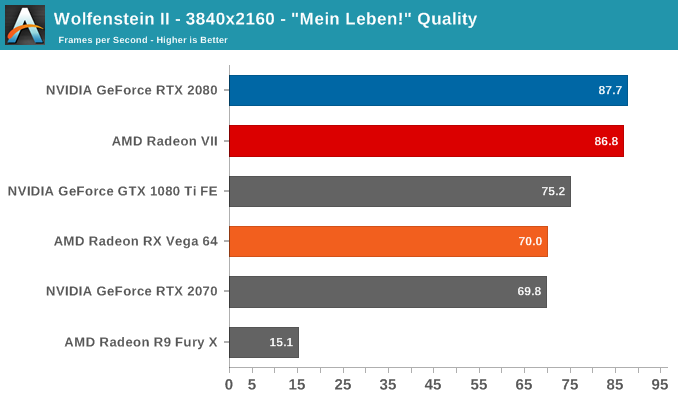
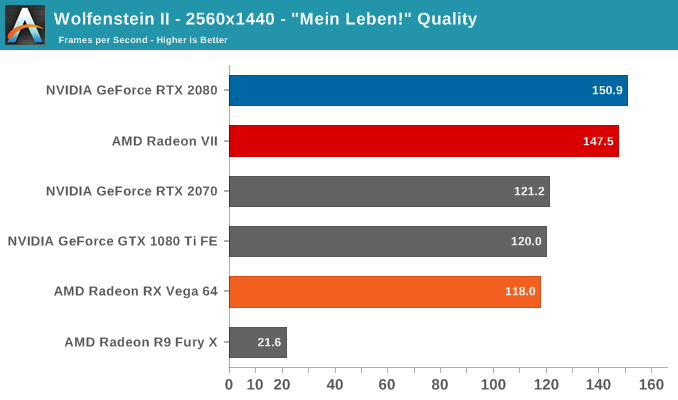
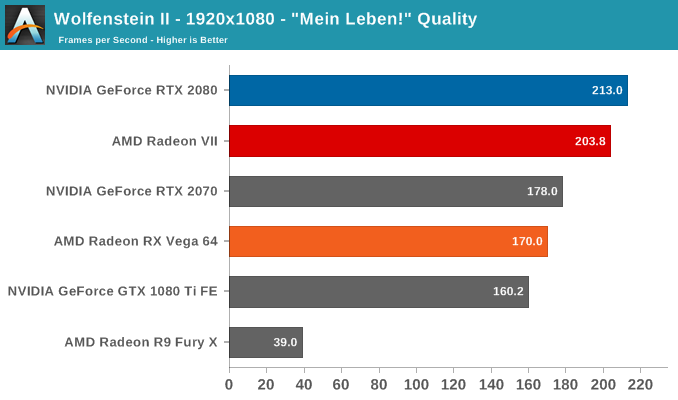
We've known that Wolfenstein II enjoys its framebuffer, and to explain the obvious outlier first the Fury X's 4GB HBM1 simply isn't enough for smooth gameplay. The resulting performance is better conveyed by 99th percentile framerates, and even at 1080p the amount of stuttering renders the game unplayable.
Returning to the rest of the cards, Wolfenstein II's penchant for current-generation architectures (i.e. Turing, Vega) is again on display. Here, the Pascal-based GTX 1080 Ti FE isn't in the running for best-in-class, with the RTX 2080 taking pole and Radeon VII in a close second. Once again, the raw lead in average frametimes grows at lower resolutions, indicating that the Radeon VII is indeed a few shades slower than the reference RTX 2080, but judging from 99th percentile data the real-world difference is close to nil.
Compared to the RX Vega 64, the performance uplift is exactly 24% at 4K and 25% at 1440p, an amusing coincidence given the guidance of 25% given earlier.
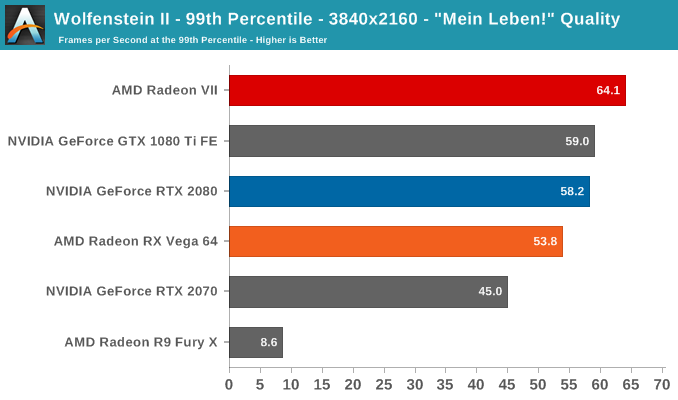
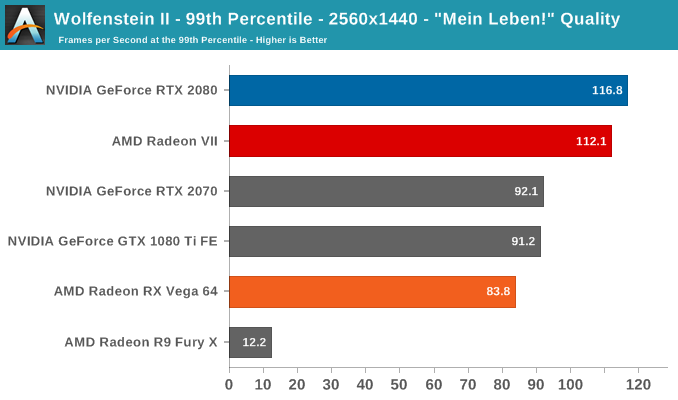
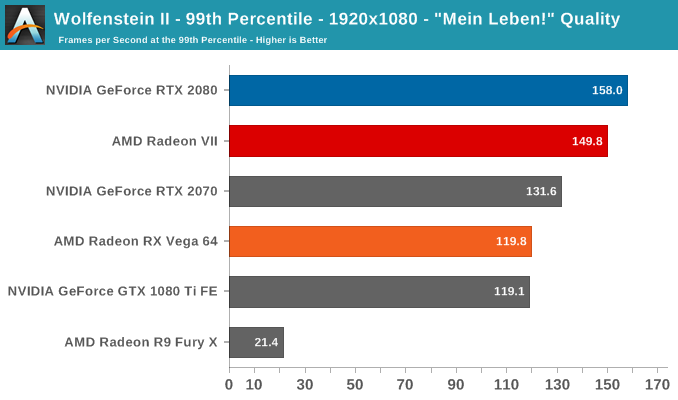


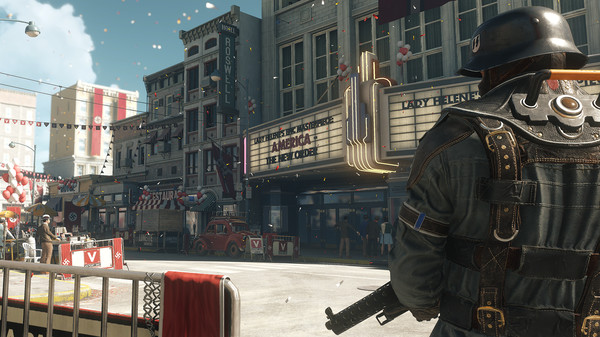








289 Comments
View All Comments
zodiacfml - Friday, February 8, 2019 - link
The first part of your conclusion describes what this product is. It is surprising to see this card's existence at 7nm, a Vega with 16GB of HBM2.It appears to me that AMD/TSMC is learning the 7nm process for GPUs/CPUs and the few chips they produce be sold as a high end part (as the volume/yields is being improved).
AMD really shot high with its power consumption (clocks) and memory to reach the pricing of the GTX 2080.
However, I haven't seen a publisher to show undervolting results. Most Vegas perform better with this tweak.
Samus - Saturday, February 9, 2019 - link
I think you are being a little too critical of this card. Considering it’s an older architecture, it’s impressive it’s in the 2080’s ballpark.And for those like me that only care about Frostbite Engin based games, this card is obviously a better option between the two cards at the same price.
You also ignored the overclockong potential of the headroom given by moving to 7nm
D. Lister - Saturday, February 9, 2019 - link
"You also ignored the overclockong potential of the headroom given by moving to 7nm"Unfortunately it seems to be already overclocked to the max on the core. VRAM has some headroom but another couple of hundred MHz isn't going to do wonders considering the already exorbitant amount available.
D. Lister - Saturday, February 9, 2019 - link
*...considering the already exorbitant amount [of bandwidth] available.Oxford Guy - Saturday, February 9, 2019 - link
"I think you are being a little too critical of this card."Unless someone can take advantage of the non-gaming aspects of it, it is dead in the water at the current price point. There is zero reason to purchase a card, for gaming only, that uses more power and creates vastly more noise at the same price point of one that is much more efficient for gaming purposes. And, the only way to tame the noise problem is to either massively undervolt it or give it water. Proponents of this GPU are going to have to show that it's possible to buy a 3 slot model and massively undervolt it to get noise under control with air. Otherwise, the claim is vaporware.
Remember this information? Fiji: 596 mm2 for $650. Vega 10 495 mm2 for $500. Vega 20 331 mm2 for $700.
Yes, the 16 GB of RAM costs AMD money but it's irrelevant for gaming. AMD not only gave the community nearly 600 mm2 of chip it paired it with an AIO to tame the noise. All the talk from Su about improving AMD's margins seems to be something that gamers need to stop lauding AMD about and starting thinking critically about. If a company only has an inferior product to offer and wants to improve margins that's going to require that buyers be particularly foolish.
Samus - Sunday, February 10, 2019 - link
I wouldn't call the 16GB irrelevant. It trumps the 2080 in the two most demanding 4K titles, and comes relatively close in other ultra high resolution benchmarks.It could be assumed that's a sign of things to come as resolutions continue to increase.
Oxford Guy - Sunday, February 10, 2019 - link
"It could be assumed that's a sign of things to come as resolutions continue to increase."Developers adapt to Nvidia, not to AMD. That appears to be why, for instance, the visuals in Witcher 3 were watered-down at the last minute — to fit the VRAM of the then standard 970. Particularly in the context of VRAMgate there was an incentive on the part of Nvidia to be certain that the 970's VRAM would be able to handle a game like that one.
AMD could switch all of its discreet cards to 32 GB tomorrow and no developers would bite unless AMD pays them to, which means a paucity of usefulness of that 32 GB.
BenSkywalker - Saturday, February 9, 2019 - link
This offering is truly a milestone in engineering.The Radeon VII has none of the RTX or tensor cores of the competition, uses markedly more power *and* is built with a half node process advantage and still, inexplicably, is slower than their direct competitor?
I've gone back and looked, I can't find another example that's close to this.
Either TSMC has *massive* problems with 7 nm or AMD has redefined terrible engineering in this segment. One of those, at least, has to be at play here.
Oxford Guy - Saturday, February 9, 2019 - link
The RTX and Tensor die area may help with power dissipation when it's shut down, in terms of hot spot reduction for instance. Vega 20 is only 331 mm2. However, it does seem clear enough that Fiji/Vega is only to be considered a gaming-centric architecture in the context of developers creating engines that take advantage of it, à la DOOM.Since developers don't have an incentive to do that (even DOOM's engine is apparently a one-off), here we are with what looks like a card designed for compute and given to gamers as an expensive and excessively loud afterthought.
Oxford Guy - Saturday, February 9, 2019 - link
There is also the issue of blasting clocks to compensate for the small die. Rip out all of the irrelevant bits and add more gaming hardware. Drop the VRAM to 8 GB. Make a few small tweaks to improve efficiency rather than just shrink Vega. With those things done I wonder how much better the efficiency/performance would be.